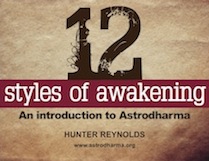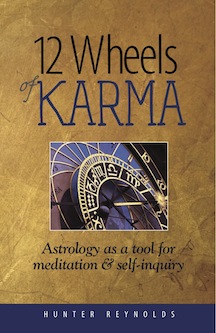 I RECENTLY READ AN ARTICLE by a iconoclastic, young satsang teacher I had never heard about. He painted a picture of the world as a meaningless Darwinian drama. All concepts of eternal life were disparaged and all eternal life-promising teachers were portrayed as self-aggrandizing hucksters. To him, your best chance at tuning into the mystery of the present moment was to divest yourself of all spiritual beliefs and confront the cold fact that we are all soulless, animal blips — a decidedly orphaned cosmology that he apparently deemed “spirituality-free” and, therefore, acceptable.
I RECENTLY READ AN ARTICLE by a iconoclastic, young satsang teacher I had never heard about. He painted a picture of the world as a meaningless Darwinian drama. All concepts of eternal life were disparaged and all eternal life-promising teachers were portrayed as self-aggrandizing hucksters. To him, your best chance at tuning into the mystery of the present moment was to divest yourself of all spiritual beliefs and confront the cold fact that we are all soulless, animal blips — a decidedly orphaned cosmology that he apparently deemed “spirituality-free” and, therefore, acceptable.
From an astrological point of view, he was slinging a Sagittarian arrow into the Sagittarian archetype. Don’t get waylaid in those pitifully self-conscious backwaters (spiritual beliefs, principles, ethics), he urged. Proceed directly to the story-less communion of Pisces. It got me curious about the unconscious ways that I, too, might be pitting belief against presence. Is it true that spiritual beliefs undermine intimacy with what is or is there such a thing as a present-friendly belief?
Clearly, the eyes of ego are glazed with distorting preconceptions, but our inherently all-embracing, witnessing presence sees — even in these corny conceptual sunglasses — an object of meditation, a doorway into the divine. Awareness wants to infiltrate the mind; spiritual egos want to lob in a pipe bomb.
Applying this tantric “include and transcend” principle to belief, one could surmise that some beliefs, if loosely held, might actually lead us to the cliff-edge of thought where we can get a better crack at free fall. In fact, some beliefs are actually designed to extinguish themselves, laying bare the luminous contours of the two-legged koans moving all around us. Buddhists call these ego-busting beliefs “skillful means.” They aren’t true; they aren’t false. They’re preciously provisional (Astrodharma being a prime example). Let’s consider a few belief-busting beliefs from Tibet.
According to Tibetan Buddhism, the telltale sign of being present is awareness of the three times: past, present and future. Meditative presence — like a window in a watchtower — allows us to survey a broader and broader temporal landscape. Surveying our moments from this panoramic vantage point, we can slow down, redirect the momentum of past habits and shrewdly consider the ramifications of our automation-tinged words and actions. Paradoxically, only something as vast as no-mind could possibly take all these past and future considerations into account!
Another provisionally helpful Buddhist belief is called “karma.” Believing that thoughts, feelings and actions shake the entire reincarnation-spiraling web of consciousness, are we not motivated to pepper a wider and wider swath of our awareness with compassionate care for self and others? Belief in karma injects sober discernment into the giddy, channel-surfing preoccupations of ego.
But what of astrology? Is it, too, a presence-friendly belief? Time to define our terms. What, for god’s sake, is this thing called “belief?”
Thoughts, beliefs and the paradigms they cluster into are simply objects in awareness – no different than rocks, trees and rivers. To demonize belief is to demonize phenomenon itself. And why in the world would we do that? Projected self-hatred? Old-fashioned evil? Nope. Simpler than that. Because all phenomena — no matter how beautiful or desirable our conscious mind may deem them, no matter whether the “stuff” is material or cerebral — is, to the mind, evidence of separation, proof that we’re alone, severed from nature, each other and the boundariless, oceanic being that, I believe, we all subliminally recognize as our true self.
From a nondual perspective, the purpose of phenomenon (pretty faces, tree trunks, racial prejudice, interminable loneliness) is to provide a surface against which our attention can ricochet back to The Attender — the one, selfsame being looking out through every pair of eyes. Accurately seen, every shred of ego’s evidence of separation is in swooning service to oneness and self-remembering. Wow.
Think of it: everyone and every thing you encounter came here to help you — you, in particular — to better savor your vast, witnessing presence. Every seemingly random event is strategic, volitional, a meditative prod. Buddhists call this Pure View. No more indifferent glances from strangers. No aesthetically beautiful but personally unsympathetic flowers and trees: just allies in awakening huddling close all around you — an entire planet populated with Buddhas rooting you on, urging you to notice how peaceful, relaxed and unborn is this one who’s looking.
Ah, but is it true? Dead question. Look around the room. Let your physiology cast a vote. Notice: how does my body feel seeing through this Buddhaful lens? What sensations arise? Ask: could something that so opens my heart and enlivens my tingly, full-bodied presence be contrived, unnatural?
Unlike religion, astrology is non-dogmatic. It is composed of intuitively recognized patterns or archetypes that can be observed in our inner psyche, in outer personalities and in the unfolding events of the world. The basic outlines of these patterns are thematically consistent but their individual expressions are infinitely unique. In addition, these archetypes overlap and continually modify each other. As such, they cannot be comprehensively defined; their presence must be felt or intuited in each individual person and circumstance. In this sense, the matrix of astrology is, indeed, a presence-friendly framework of perception because it invites us to more intelligently tune in to each passing moment and notice its repeating patterns. Astrology points to an intuitively verifiable and, I believe, benevolent design in which provisional beliefs like karma, reincarnation and pure view fit like a glove.
Unlike the aforementioned satsang teacher, astrology welcomes the phenomenon of spiritual belief as an ambassador of the element called air — an inextricable aspect of the five elements: fire, earth, air, water and ether.
Just as air contains humidity, mental constructs have emotional content (water). Just as air feeds fire, beliefs incite action (fire). Just as air interpenetrates and nourishes the body, opinions intermingle with physical sensations (earth). Finally, as every meditator knows, all four elements, all physical phenomenon, rise and fall in the substance-less medium called awareness (ether, Spirit).
To this teacher’s credit, however, I would add that my least favorite people to talk astrology with are fellow astrologers. Too often, these astro-savvy folks display a buzzy identification with their beliefs that leaves little room for relaxed, emergent knowing. It is in their company, in fact, that I am most reminded: the world is not suffering from wrong belief, but from Beliefism: the faith that if a separate somebody can just get it conceptually right we just might save our own or another’s soul, if not the planet. Alas, “final solutions” are the language of a panicked, solidity-clinging ego who has no interest in resting with no edges because it forever feels itself dissolving like the wicked witch of the west.
True/false, mainstream/occult: These content-based divisions of belief are superficial, misleading and unhelpful. In reality, there are only two kinds of belief: the presence-killing, conviction-stuffed ones and the lightly-held, provisional prompts that inspire folks to peek through the thick curtain of “somebody-ness” that keeps them feeling divided, desperate and afraid.
Ready for more?
-Schedule an astrology reading with Hunter
-Subscribe to Styles of Awakening Newsletter (monthly)
-Subscribe to posts by email
Like this article? Share it with friends:


 Get free newsletter & e-book
Get free newsletter & e-book